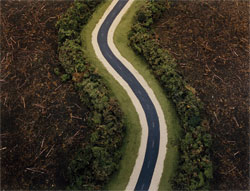Artist
Thomas Demand Archive 1995

Thomas DEMAND
German 1964–
Archive 1995
silver dye bleach print (Ilfochrome), face-mounted to acrylic, edition 4/5
183.8 x 238 cm
Solomon R. Guggenheim Museum, New York
Purchased with funds contributed by the Young Collectors Council
© Thomas Demand/VG Bild-Kunst, Bonn. Licensed by VISCOPY, Australia
97.4576
The artists shown within the Constructed Worlds section force us to look into the crevasses found in the formation of personal ‘truths’. Both Thomas Demand and Sarah Anne Johnson fabricate reality. By constructing their own worlds, and photographing them, these artists call into question the veracity of the photographic medium.
Using flimsy materials like paper and cardboard, Thomas Demand fabricates life-size reconstructions of scenes, often ones he comes across originally in photographs, newspapers or magazines. The reconstructed subjects are chosen for their representation of a violent or grim situation. These subjects have included a bombed bureau of the defunct East German secret police, the disputed ballots cast in Palm Beach County during the US Presidential election of November 2000 and Saddam Hussein’s final hiding place. The elaborately constructed sets are then photographed in order to re-cast their real-life subjects in a dubious and deliberately nuanced light. On close inspection of the resulting photograph, the sculptures are not quite perfectly reconstructed, stripped of detail, and always un-peopled. The gap between truth and fiction will always subtly show.
Archive 1995, is a reconstruction of the German film director and photographer Leni Riefenstahl’s archive: an empty room with shelves of identical grey boxes, suspiciously generic and disturbingly unlabeled, perhaps hinting at Riefenstahl’s regimental pageants glorifying the Nazis. At first glance the image seems unexceptional. Yet when the social and historical context is critically examined, the image becomes infinitely more suggestive and sinister. The boxes are all the same monotonous shape, seemingly in endless supply, and cleansed of all reference to individual identity. This monotony evokes erased memories and misplaced evidence.
